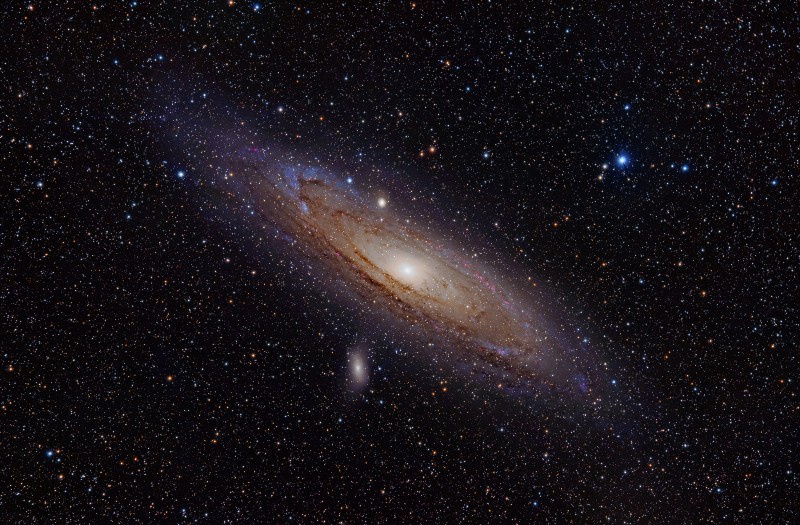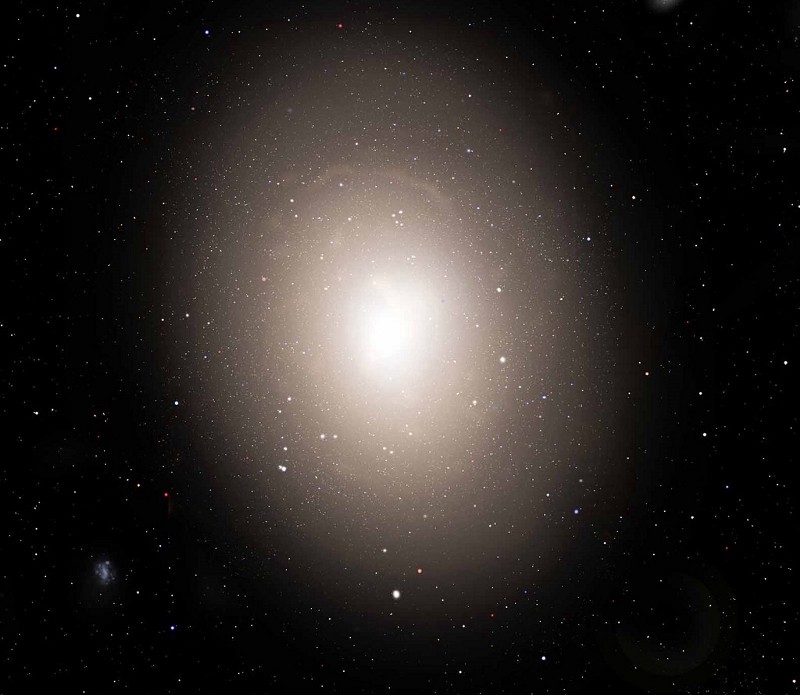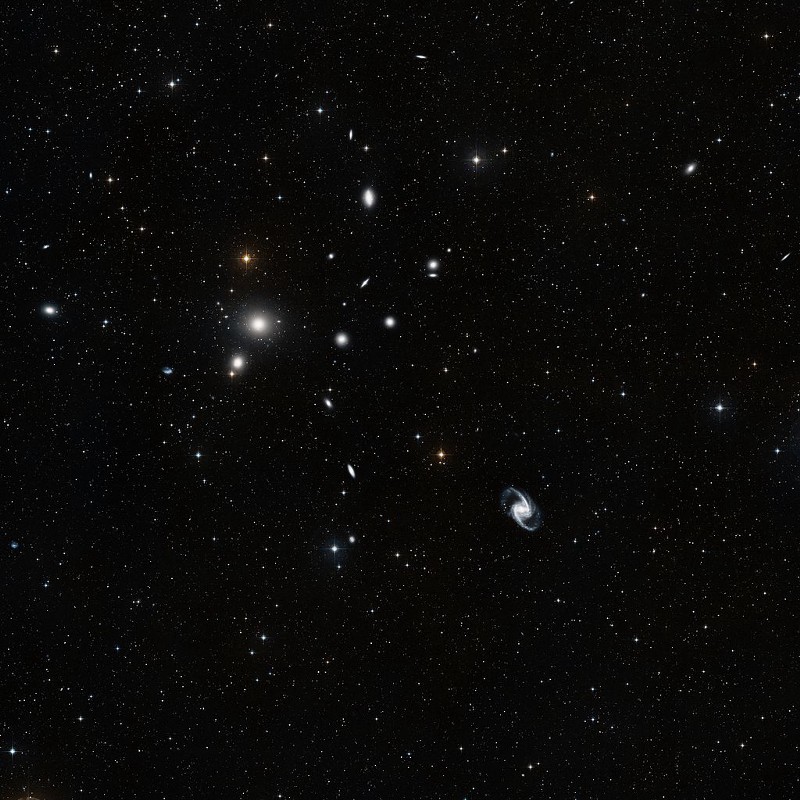Ask Ethan # 62: the largest spiral galaxy
In the universe, there are galaxies of unreal size, thousands of times larger than ours. But there is not one spiral among them!
Sometimes I sit alone under the stars
and think about the galaxies inside my heart
and wondering if anyone wants
give it all the meaning.
I want to.
- Testi McTherson
Watching the night sky from a darkened area with the naked eye, you can see the stars, planets, and even dim clusters and nebulae. But if you find a really dark moonless sky, one object dominates all the others in scale and scope: the grandiose Milky Way!

This is the plane of our galaxy, seen from the edge from our point of view from within it. It is huge, contains hundreds of billions of stars, and stretched 100,000 light years in diameter. But what about larger galaxies? Hardly our such outstanding? And on this topic this week was asked by the reader Doug Watts:
')
Why not really large galaxies? Are there any limitations that prevent spiral galaxies from becoming larger than the Milky Way or Andromeda a thousand or ten thousand times?
It turns out that the Milky Way is far from the largest of the spiral galaxies. Like Andromeda - the largest galaxy in our sky in angular size.

Of course, Andromeda looks so big in our sky because of a combination of two factors:
she really big! It contains about a trillion stars — that is, 3-5 times larger than ours, and its diameter is more than twice the diameter of our galaxy — it is 220,000 light years. This is the largest galaxy in our local group.
she is close to us! Just 2.54 million light years away - this is the closest big galaxy to us.
It’s not for nothing that the local group is called - everything that enters into it is gravitationally connected with us. In a few billion years, Andromeda, the Milky Way, the Triangle galaxy and all the other small galaxies will merge together into a single giant galaxy.
And the type of this galaxy, believe it or not, contains the answer to the reader’s question.
As a result, there will be no spiral galaxy surpassing ours, but a giant elliptical galaxy! Before we proceed to discuss the causes of this phenomenon, remember that we are engaged in science here, and considering a couple of isolated examples will not be enough. If we need to correctly calculate what will happen to the Universe, we need to take into account the whole set of observed facts, and draw conclusions from it.
If we look at all the galaxies of the universe - and choose the largest ones - what will we see?

Here is an interesting example for you - there are several galaxies in this picture, and one of them is quite comparable with the Milky Way. This is the spiral on the right - IC 4970, which interacts gravitationally with its giant neighbor.
But the giant galaxy from this picture, the one that has two huge sleeves, extends even further than the picture shows. Thanks to the ultraviolet light seen from the GALEX spacecraft, we know that, in terms of physical size, this galaxy is the largest spiral galaxy ever discovered.

This is the galaxy NGC 6872, 522,000 light-years across. Perhaps there are spirals and more, and we have found this one, since it is only “200 million light-years away” from us. However, it is much more massive than the Milky Way, Andromeda, and even them taken together - it is much larger, and, according to our ideas, a larger spiral can hardly be formed.
But there are galaxies and more of this - just all of them are elliptical!

Even after examining the Virgo cluster, the nearest large cluster of galaxies, we will find a large Messier 87 galaxy with a diameter of one million light years, containing trillions of stars, and a mass 200 times greater than ours.

The galaxy in the picture above is IC 1101, the largest galaxy found in the Universe. It is at a distance of 1.07 billion light years, contains 100 trillion stars (1000 times more than the Milky Way), its mass is 10 15 solar, the diameter is 5-6 million light years.
If we compare it with the largest of the known spiral galaxies, it turns out that it has:
- almost 100 times more stars
- several hundred times the mass
- 10 times the diameter
So the reader is right!

It is possible to find enough galaxies in the Universe - usually in the centers of giant clusters - the mass of which is hundreds and thousands of times greater than the mass of the Milky Way, but all of them are not spiral. For example, the huge and bright spiral at the bottom right in the image of the Fornaks cluster (above) has a physical size the same as the largest galaxies in the upper left, but it doesn’t even reach Andromeda in mass, and the giant elliptical galaxies are many times greater than Andromeda in mass.
So why spiral galaxies lose, starting with a certain size? To understand this, let's look at the simulation of the formation of the galaxy, with my description of the stages of development:
- In the early Universe, shortly after the Big Bang, small regions, which were fortunate enough to contain more matter and energy than others, begin to attract more matter;
- Over time, they attract so much matter that gas bunches collapse and the formation of stars and star clusters begins;
- These clusters are part of a larger, asymmetrical structure that collapses along the shortest axis and forms a disk;
- The disk acquires all new matter, collecting all the nearest clusters, and acquires a spiral shape due to density fluctuations;
- Over time, small and medium clusters, infusing into it, are drawn into the center of the galaxy, keeping the spiral structure.
This ends the simulation and this part of the story. Most likely, this is how the Milky Way, Andromeda and all other spiral galaxies were formed. A huge gas cloud collapsed due to gravity, turned into a pancake and spun. Density waves arising due to disc irregularities created a spiral pattern, and it remained so, since not a single catastrophic event broke it.
But the very process by which large galaxies are born - the merging of two or several large galaxies - and contributes to the destruction of the spiral structure!

This is what we mainly observe: isolated galaxies that have never participated in a merger have the shape of a spiral. Galaxies involved in the merger are very deformed and contain huge numbers of emerging stars. And the galaxies that recently underwent this process, and where active star formation has already been completed, calm down, forming an elliptical shape.

If we wanted the two large galaxies to merge and form a spiral, they would have to have an extremely well-matched initial configuration (which is statistically unlikely), including the desired orientation and rotation. And the more mergers of large galaxies happen, the more chances we have to destroy the spiral structure and remain with the elliptical one.
There are even several galaxies resembling a hybrid of spirals and ellipses. This is believed to have occurred as a result of a “semi-large merger”, when a large galaxy merges with a smaller one, as a result of which an elliptical shape is created, but at the same time a spiral one is preserved.

That is why the largest spiral galaxies in the Universe are not that big, and the larger galaxies go through a merger, the more likely they are to become giant elliptical, rather than spiral! Thank you for the wonderful question, Doug, and I hope that the answer satisfies your curiosity. Send me your questions and suggestions for the following articles.
Source: https://habr.com/ru/post/395467/
All Articles